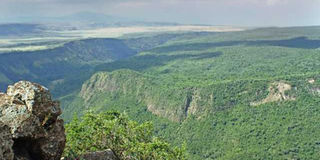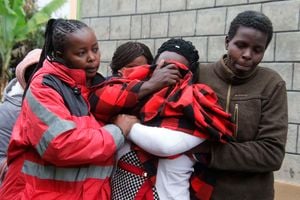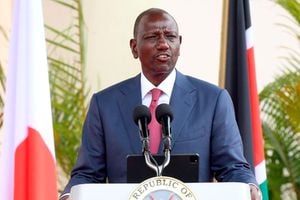Mt Suswa is home to amazing caves with more than 30 entrance points

View from Mt Suswa in Narok County, Kenya. PHOTO | KAMWETU MUTU | NATION MEDIA GROUP
What you need to know:
Inner crater is 22km long; if you want to hike the entire distance, it will take you half a day depending on your pace.
These caves are home to large populations of bats that are said to travel as far as 30km in search of food at night and then retreat to the caves in the morning.
As you walk or crawl through the caves, you can see the bats hanging from the roofs of the caves, waiting for nightfall
Mt Suswa is a magnificent volcano endowed with some of the most unlikely and amazing formations occurring in nature — a double-crater volcano with a shield-shaped cone covering an area of about 270 square kilometres.
Its inner volcano soars to an altitude of 2,356 metres above sea level at its summit.
The inner crater is covered by a forest, which is home to wildlife such as baboons, lions, leopards, spotted hyenas, civet cats, wild dogs and rock hyraxes.
This inner collapse also forms a moat-like trench surrounding a central island in the crater, creating a breathtaking view.
The outer crater, estimated at about 10km in diameter, is dotted with Maasai homesteads. Of great attraction too are the lava caves on the outer crater.
There are over 30 entrances, most of which are collapsed roofs into these caves. Fig trees and other types of vegetation mark the location of some of these openings.
These caves are home to large populations of bats that are said to travel as far as 30km in search of food at night and then retreat to the caves in the morning. As you walk or crawl through the caves, you can see the bats hanging from the roofs of the caves, waiting for nightfall.
Another interesting location in the caves is the “Baboons’ parliament”, where a large troop of the primates take shelter at night from predators.
A conservancy was established here to halt the massive degradation of the Mt Suswa ecosystem and promote sustainable use of its resources.
Tourism activities here include hiking, cave exploration, camping and wildlife tours.

Maasai elder Jeremiah Saitabao walks with students holding flaming torches during a tutorial for younger Maasai men at Suswa caves on May 22, 2014. Suswa is a sacred place for the Maasai community and is made up of an extinct volcano and cave systems. Maasai in Kenya believe that the inner crater is god's dwelling place. PHOTO | CARL DE SOUZA | AFP





